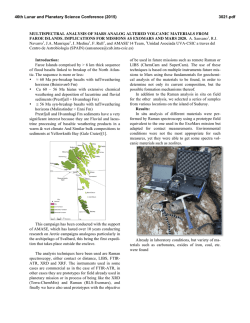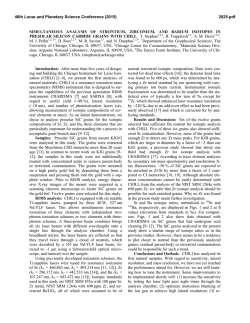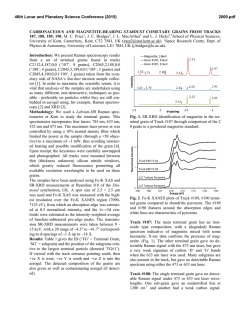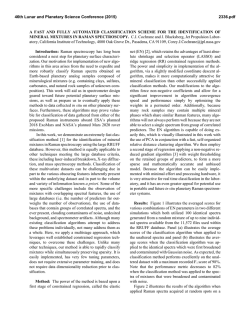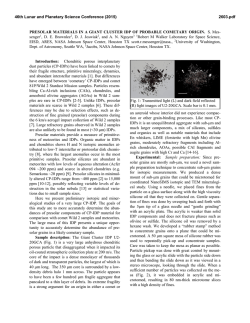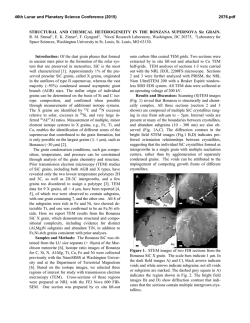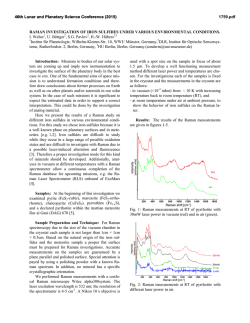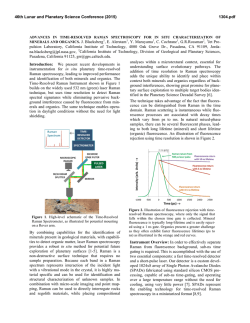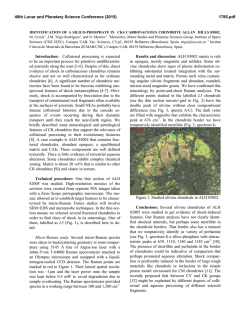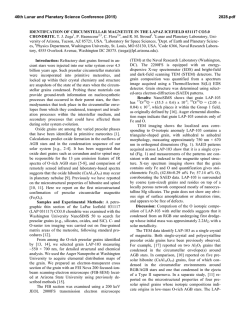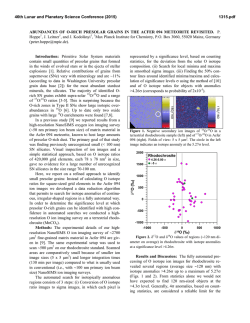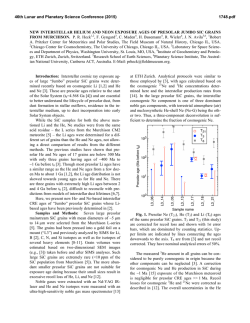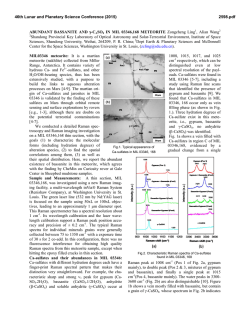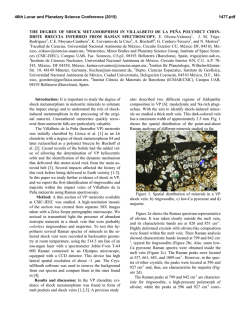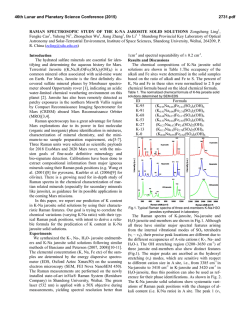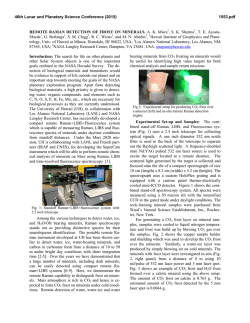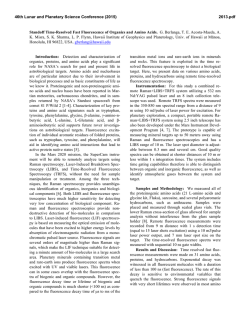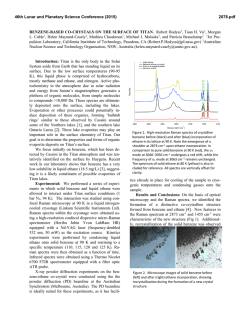
2173
46th Lunar and Planetary Science Conference (2015) 2173.pdf CORRELATION BETWEEN RAMAN PEAK SHIFTS AND ISOTOPIC COMPOSITIONS OF SUBMICRON PRESOLAR SIC GRAINS. N. Liu1, A. Steele2, L. R. Nittler1 and C. M. O’D. Alexander1 1Department of Terrestrial Magnetism, Carnegie Institution of Washington, Washington, DC 20015, USA (Email: [email protected]); 2Geophysical Laboratory, Carnegie Institution of Washington, Washington, DC 20015, USA. Introduction: Silicon carbide is a particularly interesting phase because more than a hundred different polytypes can be formed in the laboratory. The formation of these polytypes depends strongly on growth conditions (e.g., temperature, pressure). Daulton et al. [1] used TEM to study the microstructures of ~500 presolar SiC grains in an acid residue of the Murchison meteorite (KJB fraction of [2], mean diameter of 0.49 µm). They found that cubic SiC (β-SiC) is the dominant polytype for presolar SiCs (~80%). Previous Raman studies of large SiC grains (>3 µm) showed that Raman spectra can be diagnostic for distinguishing between non-cubic (hexagonal or rhombohedral, αSiC) and cubic SiC structures [3,4]. However, the grains in the previous Raman studies were of unusually large size and it is therefore of interest to study the SiC microstructural distributions in smaller, more typical size fractions with Raman microscopy. Furthermore, Ivanov et al. [5] showed that the Raman peak positions of synthetic isotope-enriched SiCs are shifted with respect to those of the same polytype but with normal isotope ratios. It is therefore intriguing to investigate whether Raman peak positions correlate with the corresponding C and Si isotope ratios in presolar SiCs, which could potentially provide a new, nondestructive, method to find rare type SiC grains with extremely anomalous C and/or Si isotope ratios (e.g., highly 13C-enriched A+B grains [6]). Samples and Methods: The SiC grains in this study were extracted from the Murchison meteorite using the isolation method described in [7] and dispersed on a high purity Au mount. Raman spectra were acquired first with a WiTeC multi-function scanning probe microscope, which includes near-field optical microscopy and confocal imaging Raman microscopy (532 nm frequency-doubled Nd:YAG laser). Its typical spatial resolution is ~400 nm at low power. Spectral images were obtained in four areas on the presolar SiC mount (each area ~50×50 µm), where each pixel contains a full Raman spectrum (~0.1Δcm-1 spectral resolution). After Raman measurements, we further verified the chemical compositions of Raman-identified SiC grains by EDS analysis with a JEOL 6500F fieldemission SEM. High-resolution Raman spectra were then acquired on single SiC grains for comparison with previous Raman scanning spectra to see if SiC Raman peaks are shifted due to the electron beam damage. Finally, the C, N and Si isotopic compositions of these SiC grains were simultaneously measured with the Carnegie NanoSIMS 50L ion microprobe using a Cs+ beam and standard methods. Results: We performed Raman and isotopic measurements on 30 presolar SiC grains. The grain sizes range from 0.2 to 2.2 µm (mean ~0.8 µm), which is similar to the size distribution of the KJD fraction of [2] (mean 0.81 µm). We succeeded in obtaining correlated data for 13 mainstream SiC grains. The C, N and Si isotopic compositions of the 30 presolar SiC grains are in good agreement with the literature data [8]. We did not see any evidence of peak shifts due to electron beam damage arising from the EDS analysis. Two of the 13 grains are hexagonal and the remainder are all cubic. This is consistent with the SiC microstructural distribution found in [1]. All the Raman and isotopic data are summarized in Table 1. Figure 1 shows high-resolution Raman spectra of one 6H- and one 3C-SiC standard, and two presolar grains. The β-SiC (e.g., 3C) has two first-order Raman active phonon modes, a TO mode at 796 cm−1 and an LO mode at 972 cm−1. The LO mode is absent in the 3C-SiC STD spectrum, probably due to the crystal orientation. In contrast, the TO mode of the α-SiC (e.g., 4H, 6H) splits into several modes. For instance, in Figure 1, the 6H-SiC standard has two TO modes at 764 and 785 cm−1 [9]. Thus, different SiC polytypes can be easily distinguished based on their Raman spectra. A1-3 A1-6 785 (TO) 963 (LO) 764 (TO) 6H-SiC STD 796 (TO) 3C-SiC STD Raman Peak Shift (cm-1) Figure 1. Raman spectra of standards (bottom two traces) and presolar SiC grains (top two traces). 46th Lunar and Planetary Science Conference (2015) 2173.pdf Table 1. Raman TO peak shifts and isotopic compositions of C, N and Si (1σ errors) for presolar SiC grains Grain A1_1 A1_2 A1_3 A1_4 A1_5 A1_6 A1_7 A2_1 A2_3 A2_4 A3_2 A4_2 A4_3 Size (µm) 1.0 0.2 1.4 0.8 0.5 0.6 0.9 0.9 0.6 0.5 1.2 2.2 1.0 TO Peak (cm-1) 776, 795 796 793 793 792 766,782 789 780 781 785 787 790 789 Type 4H 3C 3C 3C 3C 6H 3C 3C 3C 3C 3C 3C 3C 12 C/13C 46±2 108±5 54±2 93±2 73±2 60±2 62±2 26.4±0.1 15.8±0.1 63.1±0.5 53±2 64±2.1 58±2 12 13 C/ C mainstream 3C-SiC linear fitting line 95% confidence band -1 Raman TO Peak Shift (cm ) Figure 2. Plot of 12C/13C ratios versus Raman TO phonon peak shifts in 11 mainstream 3C-SiCs. Discussion: Table 1 shows that the 796 cm-1 TO phonon peak is shifted to varying degrees in the 11 3CSiC grains. The Raman peak position is sensitive to polytype variety, disorder, stress and density of charge carriers. As C and Si are the major components of the mineral SiC, rare isotopes (13C, 29Si, 30Si) may be considered as isomorphic impurities to cause possible peak shifts. Ivanov et al. [5] recently reported shifts of up to 20 cm-1 in Raman peak positions for 13C-enriched 4HSiC samples (12C/13C=1). Thus, we compared the TO peak shifts of the 11 3C-SiCs with their corresponding 12 13 C/ C ratios in Figure 2. Clearly, there exists a positive correlation between the 12C/13C ratio and the Raman TO peak shift, with eight of the 11 grains (~70%) falling within the 95% confidence bands for the fitting line. This indicates that the Raman peak shift of main- 14 N/15N δ(29Si/28Si) δ(30Si/28Si) (‰) (‰) 2673±447 -33±11 -21±13 1827±457 238±133 64±146 1684±148 86±3 93±4 913±119 9±25 -2.1±30 1344±56 42±9 66±10 2588±199 9.3±14 8.0±16 674±25 23±10 13±12 586±14 52±7 42±8 717±21 1±13 23±16 1579±100 52±8 35±9 1408±100 119±8 72±9 460±9 47±4 28±4 423±8 21±4 12±5 stream SiC grains is mainly caused by the isotope effect. However, the peak shifts of two grains with 12 13 C/ C ratios of ~60 do not follow the linear correlation. Their Raman shifts, therefore, could be dominantly caused by other effects, e.g., crystal impurities (varying trace element abundances). No correlation is observed between the peak shift and the N or Si isotopic compositions because (1) N is present in presolar SiCs as a trace element, and (2) the Si isotope ratios in mainstream SiC grains are within ±200‰, which is two orders of magnitude lower than the corresponding C isotope variation. Therefore, in most cases, Raman peak shifts appear to be dominated by the C isotope variations in mainstream SiC grains. Conclusion: This work demonstrates a clear correlation between Raman spectra and C-isotopic composition for sub-µm to µm-sized presolar SiC grains, indicating that Raman microscopy should be useful for searching for rare types of grains. Raman microscopy is relatively easy and less time-consuming than NanoSIMS analysis and since it is non-destructive, it can also preserve grains for destructive analysis with other instruments (e.g., heavy element isotope measurements by CHILI [10]) to better understand their stellar origins. Additional correlated measurements will be done to better characterize the relationship between isotopic composition and Raman spectra of presolar SiC. References: [1] Daulton T. L. (2003) GCA, 67, 4743–4767. [2] Amari et al. (1994) GCA 58, 459-470. [3] Virag A. et al. (1992) GCA, 56, 1715-1733. [4] Wopenka B. (2010) LPS XLI, Abstract#1390. [5] Ivanov et al. (2014) Mater. Sci. Forum 778-780, 471474. [6] Amari et al. (2001) ApJ 559, 463-483. [7] Alexander C. M. O’D. & Nittler (1999) ApJ 519, 222-235. [8] Zinner (2014) Treatise on Geochemistry 1, 181-213. [9] Zhang et al. (1992) J. Appl. Phys. 72, 4469-4471. [10] Stephan et al. (2014) LPS XLV, Abstract#2242.
© Copyright 2024
